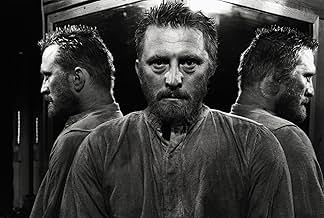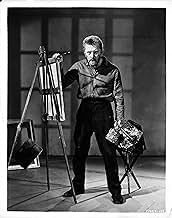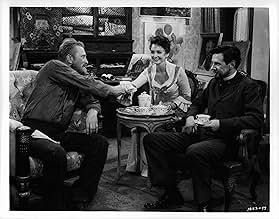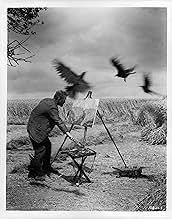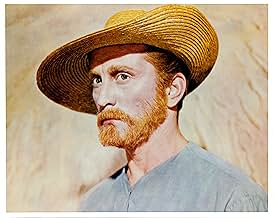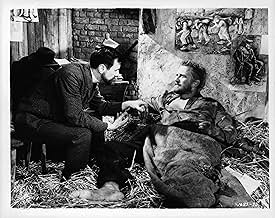- Won 1 Oscar
- 4 wins & 6 nominations total
- Directors
- Writers
- All cast & crew
- Production, box office & more at IMDbPro
Featured reviews
This is one of my favorite films. It deeply touched me. It's in my top 20 for sure. Maybe top 10. The acting, directing, and production are all about as good as it gets. It's a shame Kirk Douglas didn't win the best actor Oscar. I think it's his finest performance. I can't think of a single bad thing to say about this great movie. It's a vivid (and accurate) tribute to the immortal Vincent.
Kirk Douglas is Vincent Van Gogh in "Lust for Life," directed by Vincent Minnelli and also starring Anthony Quinn as Gaugin (Oscar winner for his performance), and James Donal as Van Gogh's brother Theo.
This film is actually based on the Irving Stone novel and while it leaves out parts of Van Gogh's life, it does seem to hit the high points. A sensitive man with a spiritual sense of life, Van Gogh seeks from the beginning to express God in some way and to give something to the world. He is unsuccessful as a minister and eventually takes up painting, supported by his loving brother Theo. Basically he lives somewhere until whomever he's living with gets sick of him and throws him out. He is a terribly lonely man, but he has an intensity that is almost frightening to people. At one point, he takes up with a sometime prostitute with a baby - she eventually leaves. In actual fact, when Van Gogh met this woman, named Sien, she was pregnant with a second child, who grew up believing Van Gogh was his father. Sien some 20+ years later commits suicide.
Van Gogh establishes a friendship with Gaugin and has dreams of an artist colony, but his relationship with Gaugin, as with everyone but his brother, ends terribly when he stalks Gaugin with an open straight razor, later cutting off part of his own ear. It is evident from the film that whatever Van Gogh's mental problem was (and there are many theories, from bipolar, to epilepsy, to schizophrenia), it worsened as time went on, as did his physical condition. He would often buy paints rather than eat and would work ceaselessly.
Van Gogh only sold one painting in his lifetime - however, what the film does not show is that, had he chosen to live, he was on the brink of being recognized for his work. His paintings had started being exhibited and appreciated and began to sell shortly after his death. What also isn't in the film is that his brother died shortly after Van Gogh did. It was Theo's widow who carried on the work that would be involved with Van Gogh's vast collection.
The film reduced me to tears - indeed, the song that says "they should have told you, Vincent, the world was never meant for one as beautiful as you" was certainly true. The only person who ever "got" Vincent was his brother.
As for the performances, Kirk Douglas makes a brilliant Van Gogh. Michael Douglas once said his father isn't considered a great actor because the style back then in the types of roles he played has changed. It's true - seen today, Douglas' work seems too intense at times, too big, too over the top in these times of acting so naturally as to almost be boring. However, I believe that Van Gogh must have been like the Douglas characterization. He obviously drove people away in large masses, and Douglas captured that passion, drive, and overeagerness perfectly. As Theo, James Donal is perfect as the calm one in the family. Anthony Quinn has a short but memorable role as the flamboyant Gaugin. He's wonderful - arrogant, opinionated, temperamental, with a bad temper, and Quinn plays him as an artist without the soul of Van Gogh. But who, after all, had the soul of Van Gogh? Vincent Minnelli lovingly directed this film and it definitely has his wonderful attention to detail, flow, and artistic touch. And the paintings are breathtaking. A beautiful film that will stay with you for a long time, and you'll never see "Starry Night" in the same way again.
This film is actually based on the Irving Stone novel and while it leaves out parts of Van Gogh's life, it does seem to hit the high points. A sensitive man with a spiritual sense of life, Van Gogh seeks from the beginning to express God in some way and to give something to the world. He is unsuccessful as a minister and eventually takes up painting, supported by his loving brother Theo. Basically he lives somewhere until whomever he's living with gets sick of him and throws him out. He is a terribly lonely man, but he has an intensity that is almost frightening to people. At one point, he takes up with a sometime prostitute with a baby - she eventually leaves. In actual fact, when Van Gogh met this woman, named Sien, she was pregnant with a second child, who grew up believing Van Gogh was his father. Sien some 20+ years later commits suicide.
Van Gogh establishes a friendship with Gaugin and has dreams of an artist colony, but his relationship with Gaugin, as with everyone but his brother, ends terribly when he stalks Gaugin with an open straight razor, later cutting off part of his own ear. It is evident from the film that whatever Van Gogh's mental problem was (and there are many theories, from bipolar, to epilepsy, to schizophrenia), it worsened as time went on, as did his physical condition. He would often buy paints rather than eat and would work ceaselessly.
Van Gogh only sold one painting in his lifetime - however, what the film does not show is that, had he chosen to live, he was on the brink of being recognized for his work. His paintings had started being exhibited and appreciated and began to sell shortly after his death. What also isn't in the film is that his brother died shortly after Van Gogh did. It was Theo's widow who carried on the work that would be involved with Van Gogh's vast collection.
The film reduced me to tears - indeed, the song that says "they should have told you, Vincent, the world was never meant for one as beautiful as you" was certainly true. The only person who ever "got" Vincent was his brother.
As for the performances, Kirk Douglas makes a brilliant Van Gogh. Michael Douglas once said his father isn't considered a great actor because the style back then in the types of roles he played has changed. It's true - seen today, Douglas' work seems too intense at times, too big, too over the top in these times of acting so naturally as to almost be boring. However, I believe that Van Gogh must have been like the Douglas characterization. He obviously drove people away in large masses, and Douglas captured that passion, drive, and overeagerness perfectly. As Theo, James Donal is perfect as the calm one in the family. Anthony Quinn has a short but memorable role as the flamboyant Gaugin. He's wonderful - arrogant, opinionated, temperamental, with a bad temper, and Quinn plays him as an artist without the soul of Van Gogh. But who, after all, had the soul of Van Gogh? Vincent Minnelli lovingly directed this film and it definitely has his wonderful attention to detail, flow, and artistic touch. And the paintings are breathtaking. A beautiful film that will stay with you for a long time, and you'll never see "Starry Night" in the same way again.
This awesome and vivid picture concerns life of brilliant but tortured artist Vincent van Gogh . He was a Post-Impressionist painter of Dutch origin whose work—notable for its rough beauty , emotional honesty, and bold color—had a far-reaching influence on 20th-century art. The picture has an opening credits prologue: Without museums help and that of private collectors the world over, this motion picture about a great painter could not have been made . Van Gogh life is a disaster , he fails at being a preacher to coal miners , he fails in his relationships with parents (Henry Daniell as Theodorus Van Gogh and wife Madge Kennedy) and women (Pamela Brown) . At the same time the movie deals with other Impressionist painters who appear across footage such as Gauguin (Anthony Quinn won well-deserved Academy Award as painter/friend) , Camille Pissarro (David Leonard) , George Seurat , Millet , Henri de Toulouse-Lautrec ; furthermore, his relationships to known characters such as his brother Theo Van Gogh (James Donald) and Dr. Gachet (Everett Sloane). After years of painful anxiety and frequent bouts of mental illness he commits himself suicide .
Magnificent rendition of Irving Stone's biography of known painter , being finely portrayed , especially his anguishes , unrewarding friendships , poorness , pains and many other things . This splendid film packs emotion , top-drawer interpretation , adequate production design , enjoyable soundtrack and exquisite color in CinemaScope . Interesting and thought-provoking screenplay by Norman Corwin . Terrific acting by the great Kirk Douglas who even had his hair cut specially in the style of the artist and had it dyed to a similar reddish tint . Over-the-top performance by Anthony Quinn as Gauguin but he does not get along with Van Gogh , his playing actually lasts 22 minutes and 40 seconds , he won his Best Supporting Actor Oscar . Evocative as well as sensitive musical score by classical composer Miklos Rozsa . Rousing and glittering cinematography by Russell Harlan and Freddie Young . The color process used for the film -Ansco color, but labeled in the credits as Metrocolor- is supposedly unsuitable for long term color preservation . As a result, many prints have lost the extraordinary brightness of the movie's images . Being shot on location , as many of the locations used for filming were the actual locations Vincent van Gogh visited in his life ; parts of the film were shot in Auvers-sur-Oise, where Vincent van Gogh lived and died . This motion picture perfectly produced by actor/producer John Houseman was stunningly directed by Vincente Minnelli who even had a portion of a field spray-painted yellow to closer resemble Vincent van Gogh's painting.
The flick is well based on actual events , these are the followings : Van Gogh spent his early adulthood working for a firm of art dealers, traveling between The Hague, London, and Paris, after which he taught for a time in England at Isleworth and Ramsgate. One of his early aspirations was to become a pastor, and from 1879 he worked as a missionary in a mining region in Belgium, where he began to sketch people from the local community. In 1885, he painted his first major work, entitled The Potato Eaters. His palette at the time consisted mainly of somber earth tones and showed no sign of the vivid coloration that distinguished his later work. In March 1886, he moved to Paris and discovered the French Impressionists. Later, he moved to the south of France and was influenced by the strong sunlight he found there. His work grew brighter in color, and he developed the unique and highly recognizable style that became fully realized during his stay in Arles in 1888. The extent to which his mental health affected his painting has been a subject of speculation since his death. Despite a widespread tendency to romanticize his ill health, modern critics see an artist deeply frustrated by the inactivity and incoherence brought about by his bouts of illness. Van Gogh's late works show an artist at the height of his ability, completely in control and "longing for concision and grace". He died aged 37 from a gunshot wound, generally accepted to be self-inflicted although no gun was ever found .
Magnificent rendition of Irving Stone's biography of known painter , being finely portrayed , especially his anguishes , unrewarding friendships , poorness , pains and many other things . This splendid film packs emotion , top-drawer interpretation , adequate production design , enjoyable soundtrack and exquisite color in CinemaScope . Interesting and thought-provoking screenplay by Norman Corwin . Terrific acting by the great Kirk Douglas who even had his hair cut specially in the style of the artist and had it dyed to a similar reddish tint . Over-the-top performance by Anthony Quinn as Gauguin but he does not get along with Van Gogh , his playing actually lasts 22 minutes and 40 seconds , he won his Best Supporting Actor Oscar . Evocative as well as sensitive musical score by classical composer Miklos Rozsa . Rousing and glittering cinematography by Russell Harlan and Freddie Young . The color process used for the film -Ansco color, but labeled in the credits as Metrocolor- is supposedly unsuitable for long term color preservation . As a result, many prints have lost the extraordinary brightness of the movie's images . Being shot on location , as many of the locations used for filming were the actual locations Vincent van Gogh visited in his life ; parts of the film were shot in Auvers-sur-Oise, where Vincent van Gogh lived and died . This motion picture perfectly produced by actor/producer John Houseman was stunningly directed by Vincente Minnelli who even had a portion of a field spray-painted yellow to closer resemble Vincent van Gogh's painting.
The flick is well based on actual events , these are the followings : Van Gogh spent his early adulthood working for a firm of art dealers, traveling between The Hague, London, and Paris, after which he taught for a time in England at Isleworth and Ramsgate. One of his early aspirations was to become a pastor, and from 1879 he worked as a missionary in a mining region in Belgium, where he began to sketch people from the local community. In 1885, he painted his first major work, entitled The Potato Eaters. His palette at the time consisted mainly of somber earth tones and showed no sign of the vivid coloration that distinguished his later work. In March 1886, he moved to Paris and discovered the French Impressionists. Later, he moved to the south of France and was influenced by the strong sunlight he found there. His work grew brighter in color, and he developed the unique and highly recognizable style that became fully realized during his stay in Arles in 1888. The extent to which his mental health affected his painting has been a subject of speculation since his death. Despite a widespread tendency to romanticize his ill health, modern critics see an artist deeply frustrated by the inactivity and incoherence brought about by his bouts of illness. Van Gogh's late works show an artist at the height of his ability, completely in control and "longing for concision and grace". He died aged 37 from a gunshot wound, generally accepted to be self-inflicted although no gun was ever found .
When I hear the name Vincente Minnelli certain scenes pop up on my inner screeningroom: A tracking shot at the fair (Some came running), the low tracking zoom towards Douglas and Turner at the pool (Bad and the Beautiful), snowmen (Meet me in St Louis) and the agony in Douglas's face in "Lust for life"; in fact as soon as his redbearded agonized face pops up, all the other movies fade away and "Lust for life" takes over my inner screening room.
But apart from being my favorite Minnelli movie, its a movie that more than any other shows his genius in use of colors; every scene is composed in breathtaking technicolor with the deepest respect for Van Gogh's own use of color, and Douglas's acting is filled with the same agony and passion as the strokes of Van Gogh's brush. As the other great movies who uses color to its fullest (Wizard of Oz, Black Narcissus, Ten Commandments), the simularities between the director and the painter is obvious. Hence, Minnelli's struggle for "painting" the scenes with the richness of technicolor becomes an echo of Van Gogh. It also reads as a textbook in composition from Steinberg's Dead Space to Eisenstein's juxtapositions. In all, Minnelli is of great skill and uses it to the fullest.
The story, which focuses on the struggle for a new way of expression, is tame at times and the acting (apart from Douglas) seems static most of the times, but the tortured face and body of Douglas and the use of color makes this one of the greatest achievements in MGM's history and one of the best movies Minnelli ever made.
But apart from being my favorite Minnelli movie, its a movie that more than any other shows his genius in use of colors; every scene is composed in breathtaking technicolor with the deepest respect for Van Gogh's own use of color, and Douglas's acting is filled with the same agony and passion as the strokes of Van Gogh's brush. As the other great movies who uses color to its fullest (Wizard of Oz, Black Narcissus, Ten Commandments), the simularities between the director and the painter is obvious. Hence, Minnelli's struggle for "painting" the scenes with the richness of technicolor becomes an echo of Van Gogh. It also reads as a textbook in composition from Steinberg's Dead Space to Eisenstein's juxtapositions. In all, Minnelli is of great skill and uses it to the fullest.
The story, which focuses on the struggle for a new way of expression, is tame at times and the acting (apart from Douglas) seems static most of the times, but the tortured face and body of Douglas and the use of color makes this one of the greatest achievements in MGM's history and one of the best movies Minnelli ever made.
This film is a rarity, a biopic which is more accurate than the book it's based on. Irving Stone's book was a major best-seller which did much to make Vincent Van Gogh one of the ten most famous artists in history but it did have its inaccuracies, particularly when it depicted its protagonist in Paris with other great painters of the time. In the book, Gauguin, Lautrec, Cezanne and Rousseau come off as typical bohemians while Vincent was made much more of a leader than he was. Minelli doesn't give us a detailed look at any of the artists except Gauguin but he is more accurate about who influenced Van Gogh and he does include his best friend, the now-forgotten Emile Bernard, if only as an extra in Tanguy's shop.
When Lust for Life came out, several critics dismissed it as too lurid and melodramatic, but those adjectives are accurate in describing Van Gogh's life. Note that Kirk Douglas does not play his usual cool, fun-loving tough guy and actually uses his whole body in his acting. For once Hollywood outdid itself.
When Lust for Life came out, several critics dismissed it as too lurid and melodramatic, but those adjectives are accurate in describing Van Gogh's life. Note that Kirk Douglas does not play his usual cool, fun-loving tough guy and actually uses his whole body in his acting. For once Hollywood outdid itself.
Did you know
- TriviaMany of the locations used for filming were the actual locations Vincent van Gogh visited in his life.
- GoofsAt Arles, when Paul Gauguin is explaining his philosophy, Vincent mistakes him for Theo saying "but Theo, err Paul..." However, this is in the script. The whole point of the line is that Van Gogh views his conversation with Gauguin as nothing more than an extension of talks he's had with Theo since childhood.
- Quotes
Paul Gauguin: I'm talking about women, man. Women. I like 'em fat and vicious and not too smart. Nothing spiritual either. To have to say 'I love you' would break my teeth. I don't want to be loved.
Vincent Van Gogh: You really mean that, Paul.
- ConnectionsFeatured in Van Gogh: Darkness Into Light (1956)
- SoundtracksLa Marseillaise
(1792) (uncredited)
Written by Claude Joseph Rouget de Lisle
Played by a band in France, near the end
Details
Box office
- Budget
- $3,227,000 (estimated)
- Runtime
- 2h 2m(122 min)
- Aspect ratio
- 2.55 : 1
Contribute to this page
Suggest an edit or add missing content

![Watch Trailer [OV]](https://m.media-amazon.com/images/M/MV5BNjMwYjdhMDItMDA1NC00YjJlLWFhZjctYWY5YjBlNDdiODFiXkEyXkFqcGdeQXRyYW5zY29kZS13b3JrZmxvdw@@._V1_QL75_UX500_CR0)
